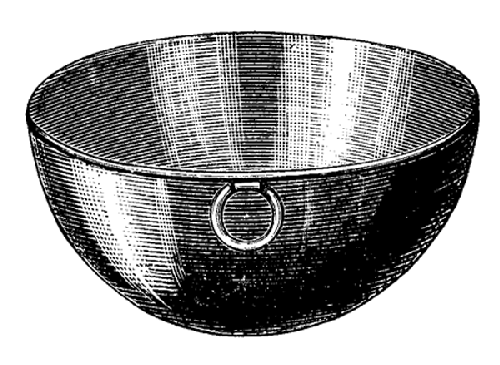I have a thing against cake mixes.
Sure, commercial mixes produce very consistent results—they use food additives and
stabilizers exactly calibrated for the other ingredients in the cake mix—but even for
a quick birthday cake, you can make a truly homemade one that actually tastes like
chocolate without much more work.
Note:
Cakes are commonly made using a two-stage method, in which
dry ingredients are weighed out and whisked in one bowl, wet ingredients are whisked
in a second bowl, and then the two are combined. In the streamline
method, all ingredients are mixed in the same bowl: first dry (to make
sure the baking powder is thoroughly blended), then wet, then eggs.
In a large bowl or the large bowl of a
mixer, measure out:
2 ¼ cups (450g) sugar
2 cups (240g) pastry or cake flour (all-purpose flour is
okay, too)
¾ cup (70g) cocoa powder (unsweetened)
2 teaspoons (10g) baking soda
½ teaspoon (2g) salt
Whisk together the dry ingredients, then add to the same bowl and whisk to combine
thoroughly (about a minute):
1 ½ cups (360g) buttermilk
1 cup (218g) canola oil
1 teaspoon (5g) vanilla extract
Add eggs and whisk to combine:
3 large (180g) eggs
Prepare two 9″ / 22 cm or three 8″ / 20 cm round cake pans by lining the bottom with
parchment paper. Yes, you really need to do this; otherwise, the cakes will stick and
tear when you try to remove them. Spray the paper and pan sides with nonstick spray or
coat with butter, and then dust with either flour or cocoa powder.
Note:
The parchment paper doesn’t need to cover every last square millimeter of the
bottom of the cake pan. Cut a square of parchment paper, and fold it in half, then in
quarters, and then in eighths. Snip the top off the folded paper, unfold your octagon,
and place it in the pan.
Divide the batter into the cake pans. Try using a scale to keep the weights of the
pans the same; this way the cakes will all be roughly the same height.
Bake in an oven preheated to 350°F / 175°C until a toothpick comes out clean, about
30 minutes. Allow to cool before turning out and frosting. If your cakes sink in the
middle, your oven is probably too cold.
Note:
Even professional bakers use toothpicks to check doneness. For brownies, check
that a toothpick inserted 1″ / 2.5 cm deep comes out clean; for cakes, push the
toothpick in all the way.
Notes
When placing the cake pans in the oven, put them on a wire rack in the
middle of the oven. If you keep a pizza or baking stone in your oven (which is
recommended), don’t set the cakes directly on the stone; put them on a rack above
the stone.
Like buttermilk, baking cocoa powder is acidic! Dutch
process cocoa powder, however, is alkalinized—that is, it has had its pH
level adjusted, changing it from a pH of around 5.5 to a pH between 6.0 and 8.0,
depending upon the manufacturer. Don’t just blindly substitute Dutch process cocoa
powder for straight-up cocoa powder; some of the baking soda will need to be
switched out for baking powder.
You can sometimes make a buttermilk substitute by adding 1 tablespoon
(15g) of vinegar or lemon juice to 1 cup (240g) of milk. This will adjust the pH
to be roughly the same as that of a cup of buttermilk, but it will not create the
same texture or thickness, so don’t use that substitute for this recipe. If you
don’t have buttermilk, use regular milk and substitute baking powder for half of
the baking soda.
Note the baking temperature of 350°F / 175°C, sugar doesn’t begin to
noticeably brown until above this temperature. You can tell a lot about what kind
of baked good you’ll end up with just by looking at the baking
temperature.

Simple Chocolate Ganache Frosting
In a saucepan over medium heat, heat 1 cup (240g) of heavy cream until it just
begins to boil. Remove from heat and add 2 tablespoons (30g) of butter and 11½ oz (325g)
of finely chopped bittersweet chocolate. (You can use semi-sweet chocolate if you prefer
your cakes on the sweeter side. Most chocolate chips are semi-sweet; try using those.)
Allow to rest until the chocolate and butter have melted, about five minutes. Add a
pinch of salt and whisk to thoroughly combine.
To frost the cake, you can just pour the still-warm ganache over the top, allowing
it to run down the sides. (This can get messy—which can serve as an excuse for eating
half the ganache while frosting.) Or, to create a more traditional frosting, allow the
ganache to set in the fridge, about 30 minutes, and then use an electric beater or mixer
to beat it until it’s light and fluffy. Coat the top of each layer of the cake with the
whipped ganache and stack them, leaving the sides exposed.
Notes
Try spiking the frosting with a tablespoon of espresso or liquor such
as rum, port, or Grand Marnier. For a tangier frosting, substitute buttermilk for
half of the heavy cream. If you really want to push the boundaries, trying using
anything you think would work in a truffle. Cinnamon is easy to imagine, but why
not cayenne pepper or lavender? Or infuse the cream with Earl Grey
tea.
Make sure your cake is cool before frosting; otherwise, the heat will
melt the ganache.